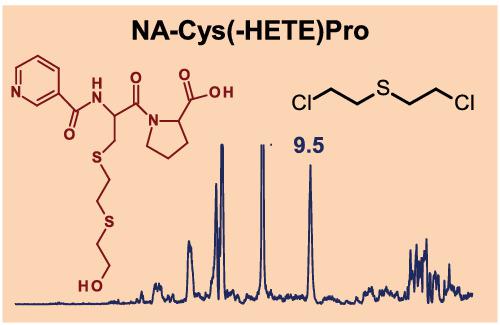当前位置:
X-MOL 学术
›
Drug Test. Anal.
›
论文详情
Our official English website, www.x-mol.net, welcomes your
feedback! (Note: you will need to create a separate account there.)
Evidence of sulfur mustard poisoning by detection of the albumin-derived dipeptide biomarker C(-HETE)P after nicotinylation
Drug Testing and Analysis ( IF 2.6 ) Pub Date : 2021-06-18 , DOI: 10.1002/dta.3114 Harald John 1 , Annika Richter 2 , Horst Thiermann 1
Drug Testing and Analysis ( IF 2.6 ) Pub Date : 2021-06-18 , DOI: 10.1002/dta.3114 Harald John 1 , Annika Richter 2 , Horst Thiermann 1
Affiliation

|
Sulfur mustard (SM, bis[2-chloroethyl]-sulfide) is a banned chemical warfare agent that was frequently used in recent years and led to numerous poisoned victims who developed painful erythema and blisters. Post-exposure analysis of SM incorporation can be performed by the detection of human serum albumin (HSA)-derived peptides. HSA alkylated by SM contains a hydroxyethylthioethyl (HETE)-moiety bound to the cysteine residue C34 yielding the dipeptide biomarker C(-HETE)P after pronase-catalyzed proteolysis. We herein present a novel procedure for the selective precolumn nicotinylation of its N-terminus using 1-nicotinoyloxy-succinimide. The reaction was carried out for 2 h at ambient temperature with a yield of 81%. The derivative NA-C(-HETE)P was analyzed by micro liquid chromatography-electrospray ionization tandem-mass spectrometry working in the selected reaction monitoring mode (μLC-ESI MS/MS SRM). The derivative was shown to be stable in the autosampler at 15°C for at least 24 h. The single protonated precursor ion (m/z 428.1) was subjected to collision-induced dissociation yielding product ions at m/z 116.1, m/z 137.0, and m/z 105.0 used for selective monitoring without any plasma-derived interferences. NA-C(-HETE)P showed a mass spectrometric response superior to the non-derivatized dipeptide thus yielding larger peak areas (factor 1.3 ± 0.2). The lower limit of identification corresponded to 80 nM SM spiked to plasma in vitro. The presented procedure was applied to real case plasma samples from 2015 collected in the Middle East confirming SM poisoning.
中文翻译:

通过检测烟碱化后白蛋白衍生的二肽生物标志物 C(-HETE)P 发现芥子气中毒的证据
芥子气(SM,双[2-氯乙基]-硫化物)是一种禁用的化学战剂,近年来经常使用,导致许多中毒的受害者出现疼痛的红斑和水泡。SM 掺入的暴露后分析可以通过检测人血清白蛋白 (HSA) 衍生的肽来进行。由 SM 烷基化的 HSA 含有与半胱氨酸残基 C 34结合的羟乙基硫乙基 (HETE)-部分在链霉蛋白酶催化的蛋白水解后产生二肽生物标志物 C(-HETE)P。我们在此提出了一种使用 1-烟酰氧基-琥珀酰亚胺对其 N 端进行选择性柱前烟碱化的新程序。反应在环境温度下进行2小时,产率为81%。衍生物 NA-C(-HETE)P 采用微量液相色谱-电喷雾电离串联质谱法在选定的反应监测模式 (μLC-ESI MS/MS SRM) 下进行分析。该衍生物在 15°C 的自动进样器中显示稳定至少 24 小时。单个质子化前体离子 ( m / z 428.1) 经受碰撞诱导解离,在m / z 116.1、m / z处产生产物离子137.0 和m / z 105.0 用于选择性监测,没有任何等离子体衍生的干扰。NA-C(-HETE)P 显示出优于非衍生二肽的质谱响应,因此产生更大的峰面积(因子 1.3 ± 0.2)。鉴定的下限对应于体外加标到血浆中的 80 nM SM。所提出的程序适用于 2015 年在中东收集的真实案例血浆样本,确认 SM 中毒。
更新日期:2021-06-18
中文翻译:

通过检测烟碱化后白蛋白衍生的二肽生物标志物 C(-HETE)P 发现芥子气中毒的证据
芥子气(SM,双[2-氯乙基]-硫化物)是一种禁用的化学战剂,近年来经常使用,导致许多中毒的受害者出现疼痛的红斑和水泡。SM 掺入的暴露后分析可以通过检测人血清白蛋白 (HSA) 衍生的肽来进行。由 SM 烷基化的 HSA 含有与半胱氨酸残基 C 34结合的羟乙基硫乙基 (HETE)-部分在链霉蛋白酶催化的蛋白水解后产生二肽生物标志物 C(-HETE)P。我们在此提出了一种使用 1-烟酰氧基-琥珀酰亚胺对其 N 端进行选择性柱前烟碱化的新程序。反应在环境温度下进行2小时,产率为81%。衍生物 NA-C(-HETE)P 采用微量液相色谱-电喷雾电离串联质谱法在选定的反应监测模式 (μLC-ESI MS/MS SRM) 下进行分析。该衍生物在 15°C 的自动进样器中显示稳定至少 24 小时。单个质子化前体离子 ( m / z 428.1) 经受碰撞诱导解离,在m / z 116.1、m / z处产生产物离子137.0 和m / z 105.0 用于选择性监测,没有任何等离子体衍生的干扰。NA-C(-HETE)P 显示出优于非衍生二肽的质谱响应,因此产生更大的峰面积(因子 1.3 ± 0.2)。鉴定的下限对应于体外加标到血浆中的 80 nM SM。所提出的程序适用于 2015 年在中东收集的真实案例血浆样本,确认 SM 中毒。











































 京公网安备 11010802027423号
京公网安备 11010802027423号